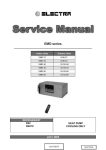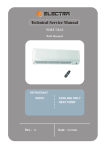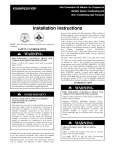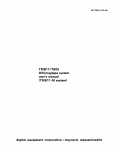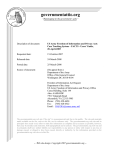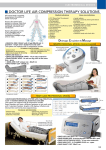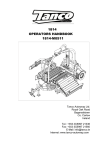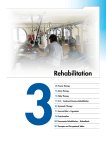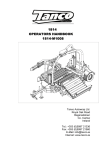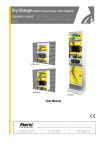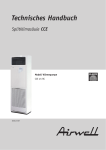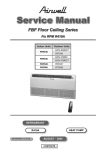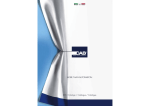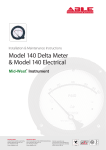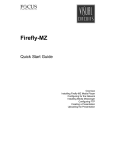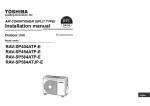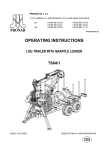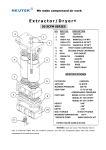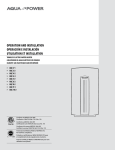Download 05__Technical Manual CCE 45 au R407c
Transcript
Technical Service Manual SERIES: FS KFR120L Free Standing AM C FM 1 2 AUTO FM REFRIGERANT R407C Rev.: 01 ELECTRA CONSUMER PRODUCTS LTD HEAT PUMP Date: Rev.: 01 29/02/04 Series: FS Date: 20/02/2004 FS 1200 Model Installation method Characteristic Wall mounted Units Kcal/hr Btu/hr W W W/W Capacity Total input COP/EER Power supply (voltage, cycle) Circuit breaker rating I N D O O R Noise Power Condensate drain tube I.D Dimensions U N I T O U T D O O R U N I T T U B E S A C C. W D H Weight Package dimensions Units per palet Height stacking Refrigerant control Compressor type & model Fan type & qty. Fan speed - HI Airflow Noise Power Dimensions Weight Packing dimensions Height stacking Units per palet Refrigerant Charge Condensate drain tube I.D Tube size O.D Connection between units W D H RPM 3 m /hr (CFM) dBA mm mm mm mm Kg mm units units RPM m /hr (CFM) dBA mm mm mm Kg mm units units gram mm liquid in. suction in. Indoor-Outdoor height difference tubing length Operation control type Heating elements Ducts Others ELECTRA CONSUMER PRODUCTS LTD Heating 12800 51200 15000 4567 2.86 400/50/3 3X16 Centrifugal A Fan type & qty. Fan speed (HI) Airflow (HI) Cooling 11000 44000 12900 4824 2.55 2000 1177 52 / 56 25 600 370 1900 70 2000*710*490 4 1 R-407C SCROLL HR61YAB LG AXIAL X 2 1125 4200 (2470) 69 900 340 970 95 985*406*1016 2 6 R407C 3750 16 3/8 3/4 MAX. 20m MAX. 40m Operation by hand on LCD W Rev.: 01 Series: FS Date: 20/02/2004 NOTES: 1. Rating conditions ISO/CD 13253R Cooling: indoor: 27°C (80°F) DB 19°C (66°F) WB Outdoor: 35°C (95°F) DB Heating: indoor: 20°C (68°F) DB Outdoor: 7°C (45°F) DB 6°C (43°F) WB Refrigerant tubing length (one way) 7.5m (24.6 ft) 2. Guaranteed operating range: Cooling Heating Voltage Upper limit Lower limit Upper limit Lower limit 1 PH 3 PH ELECTRA CONSUMER PRODUCTS LTD Indoor 32°C DB, 23°C WB 21°C DB, 15°C WB 27°C DB 20°C DB Outdoor 46°C DB 21°C DB 24°C DB, 18°C WB -9°C DB, -10°C WB 198 – 242 V 360 – 440 V Rev.: 01 Series: FS Date: 20/02/2004 FS KFR 120L /OU10-50 R407C ELECTRA CONSUMER PRODUCTS LTD Rev.: 01 Series: FS Date: 20/02/2004 Model: FS KFR 120L FS1200T R407c COOLING CAPACITY 18,000 17,000 Indoor Temp. CAPACITY [W) 16,000 30 C DB/50%RH 26 C DB/50%RH 15,000 23 C DB/50%RH 14,000 13,000 12,000 11,000 10,000 10 15 20 25 30 35 40 45 Outdoor Tem p. (C DB) FS1200T R407c HEATING CAPACITY 21,000 18,500 CAPACITY [W) 16,000 13,500 Indoor Temp. 11,000 20 C DB 8,500 18 C DB 15 C DB 6,000 -10 -5 0 5 10 15 Outdoor Tem p. (C DB) ELECTRA CONSUMER PRODUCTS LTD Rev.: 01 Series: FS Date: 20/02/2004 Model: FS KFR 120L FS1200T R407c COOLING TOTAL INPUT 6,500 6,000 5,500 TOTAL INPUT (W) 5,000 4,500 4,000 3,500 Indoor Temp. 3,000 30 C DB/50%RH 2,500 26 C DB/50%RH 2,000 23 C WB/50%RH 1,500 10 15 20 25 30 35 40 45 Outdoor Tem p. (C DB) FS1200T R407c HEATING TOTAL INPUT 6,500 6,000 TOTAL INPUT (W) 5,500 5,000 4,500 4,000 Indoor Temp. 3,500 20 C DB 18 C DB 3,000 15 C DB 2,500 -10 -5 0 5 10 15 Outdoor Tem p. (C DB) ELECTRA CONSUMER PRODUCTS LTD Rev.: 01 Series: FS Date: 20/02/2004 Model: FS KFR 120L FS1200T R407c COOLING DISCHARGE PRESSURE 30.0 DISCHARGE PRESSURE [Bar(g 25.0 20.0 15.0 Indoor Temp. 30 C DB/50%RH 10.0 26 C DB/50%RH 23 C DB/50%RH 5.0 10 15 20 25 30 35 40 45 Outdoor Tem p. (C DB) FS1200T R407c HEATING SUCTION PRESSURE 5.00 SUCTION PRESSURE [Bar(g) 4.50 4.00 3.50 3.00 Indoor Temp. 2.50 20 C DB 2.00 18 C DB 15 C DB 1.50 -10 -5 0 5 10 15 Outdoor Tem p. (C DB) ELECTRA CONSUMER PRODUCTS LTD Rev.: 01 Series: FS Date: 20/02/2004 Model: FS KFR 120L FS1200T R407c COOLING SUCTION PRESSURE 5.5 SUCTION PRESSURE [Bar(g) 5.0 4.5 4.0 Indoor Temp. 30 C DB/50%RH 3.5 26 C DB/50%RH 23 C DB/50%RH 3.0 10 15 20 25 30 35 40 45 Outdoor Tem p. (C DB) FS1200T R407cHEATING DISCHARGE PRESSURE 24 23 DISCHARGE PRESSURE [Bar(g 22 21 20 19 18 Indoor Temp. 17 20 C DB 16 18 C DB 15 14 -10 15 C DB -5 0 5 10 15 Outdoor Tem p. (C DB) ELECTRA CONSUMER PRODUCTS LTD Rev.: 01 Series: FS Date: 20/02/2004 Model: FS KFR 120L ELECTRA CONSUMER PRODUCTS LTD Rev.: 01 Series: FS Date: 20/02/2004 HEAT PUMP MODELS SERIES: FS KFR 120L ELECTRA CONSUMER PRODUCTS LTD Rev.: 01 Series: FS Date: 20/02/2004 Tubing Connections Model: FS KFR 120L Outdoor Unit Suction line Outdoor Unit Tube bending Liquid line Suction line Tube bending R 3.5 Flare nut Liquid line Pipe insulation R 3.5 Flare nut Insulating sleeve Pipe insulation Indoor Insulating sleeve Unit R Indoor Unit R Tube (Inch) 1/4” 3/8” 1/2” 5/8” 3/4” TORQUE(N.m.) 2 1 FLARE NUTS 11-13 40-45 60-65 70-75 80-85 VALVE CAP 13-20 13-20 18-25 18-25 40-50 SERVICE PORT CAP 11-13 11-13 11-13 11-13 11-13 Tightening Torque Values 3 4 5 7 6 8 1. Valve Protection Cap-end 2. Use Allen Wrench to open/close the Refrigerant Valve 3. Valve Protection Cap 4. Refrigerant Valve 5. Service Port Cap 6. Flare Nut 7. Unit Back Side 8. Copper Tube When the outdoor unit is installed above the indoor unit an oil trap is required every 5m along the suction line at the lowest point of the riser. In case the indoor unit is installed above the outdoor no trap is required. Outdoor : Indoor ELECTRA CONSUMER PRODUCTS LTD Rev.: 01 Series: FS Date: 20/02/2004 ELECTRA CONSUMER PRODUCTS LTD Rev.: 01 Series: FS Date: 20/02/2004 Free Standing Air Conditioner AM C FM 1 2 AUTO FM Operation Instructions & Installation Manual Operation Instructions Page Introduction 1 System Description 2 Operation Modes, Functions and Features 3 Indicator Lights of the Indoor Unit and Control Buttons on the Unit 5 Operational Principal of the Unit 6 Specifications and Technical Parameters 7 Operation Procedure (Operations on the Unit) 8 Turning on the Air Conditioner 8 Ventilating Operation 8 Cooling Operation 8 Cooling Operation with Auto Fan Mode 9 Heating Operation 9 Heating Operation With Auto Fan Mode 9 Dry Operation 9 Temperature Selecting 9 Sleep Function 10 Timer Function 10 Operation Modes for Timer Function 10 Air Direction Control 12 Turning Off 12 Lock Function 12 Protection Modes and Instructions for Service Electric Heater 13 Maintenance and Care 14 Operating Tips 15 Preventive Measures 16 Before Calling For Service 18 If your air conditioner is for cooling only, please disregard the heating instructions. Please read these instructions before operating the air conditioner. The change of function parameters and circuit diagram will not be notified; please refer to the nameplate and the circuit diagram on the unit. Installation Instructions Page 1. Outline Dimensions for Indoor & Outdoor Unit 19 2. Installation Process Chart 20 3. Installation of Indoor Unit 21 3.1 Selecting Location for Indoor Unit Installation 21 3.2 Indoor Unit Installation 22 3.3 Refrigerant Line Installation 24 3.4 Drain Line Installation 24 3.5 Electrical Cable Connections 27 4. Outdoor Unit Installation 29 4.1 Selecting Location for Outdoor Unit Installation 29 4.2 Outdoor Unit Installation 31 4.3 Interconnection and leak detection of Refrigerant Line 32 4.4 System Installation 33 4.5 Electrical Layout and Wiring Method 34 4.6 Test Operation 36 4.7 Drain Condensing Water (used only by heat pump unit) 37 5. Wiring Diagram 38 INTRODUCTION The free Standing air conditioner is designed for various uses: Cooling in summer Operating Temperature Range Indoor Dehumidifying at high humidity conditions. Outdoor Cooling 16 oC ~ 30 oC 10 oC ~ 46 oC Heating 16 oC ~ 30 oC Heating -10oC ~ 21oC Air Filter IMPORTANT NOTICE: Ventilation The air conditioner must be grounded to protect against electrical shock. Installation of the air conditioner must be performed by an experienced air conditioning installer, observing good refrigeration practice. AM C FM 1 2 FM AUTO Electrical connections and power cord replacement should only be made by authorized electricians and in accordance with electrical regulations and local codes. Failure to comply with the manufacturer s installation and operation instructions could affect the performance of the air conditioner and the validity of the warranty. SYSTEM DESCRIPTION Indoor Unit Outdoor Unit Air In Air Out Air Outlet AM C 1 2 FM AUTO FM Control Panel Air Out Air Out Air Inlet Air In Drain Tube Interconnecting Lines OPERATION MODES, FUNCTIONS AND FEATURES This series of conditioners have the following functions: COOL HEAT Cools, dehumidifies and filters the room air. Maintains desired room temperature. Heats and filters the room air. Maintains the desired room temperature. Automatically switches from COOLING to HEATING or from HEATING to AUTO COOLING, maintaining the desired temperature according to the room conditions. DRY Decreases humidity of atmosphere and maintains the room temperature. It is suitable to use in dankish and rainy season. FAN Recirculates and filters the room air. Maintains constant air movement in the room. The air conditioner automatically selects the fan speed according to the AUTO FAN room temperature. At the start, the unit operates at high fan speed. As the room air approaches to the set temperature, the fan switches automatically to a lower speed for quieter operation. In HEATING and in AUTO FAN, the fan will be turned off when the HOT KEEP compressor is not in operation and will not be restarted, unless the indoor coil reaches adequate temperature. This HOT KEEP feature prevents uncomfortable cold air drafts. Use of AUTO FAN is, therefore, recommended when the air conditioner is in HEATING mode. TIMER Real time control and display, automatically turns the air conditioner ON and OFF according to the time of day setting, ensuring comfort conditions before returning home, without wasting electricity. It turns the air conditioner off automatically when sleeping. SLEEP Designed to create comfortable sleeping conditions. When in cooling mode, the temperature rises one-degree centigrade after each consecutive hour, up to three hours, from the start of the mode. The rising temperature prevents the feeling of over-cooling while sleeping (when your body is at rest). In heating mode the reverse occurs; the air conditioner lowers its temperature one-degree every hour. When in sleeping mode, air conditioner will be automatically turned off after operating for seven hours. The result is a more comfortable and invigorating sleep, which leaves you feeling fresh and energetic on the next morning. OPERATION MODES, FUNCTIONS AND FEATURES FILTER INDICATOR Filter indicator on the indoor unit display is turned on when when the filter requires cleaning. After cleaning and reinstalling the filter. The system should be reset. 3-MIN. DELAYED RNU The compressor is protected by a three-minute delayed restart. MEMORY The microprocessor retains the last data entry whether or not the unit is plugged in. Therefore, when the unit restarts after a power distruption or failure, it will resume operating in the same mode as before the power was disrupted. LOCK Freezes the last operation setting on the remote control. When LOCK is activated, the remote control will the be able to control the air-conditioner. INDICATOR LIGHTS AND CONTROL BUTTONS ON THE UNIT A. Stand-by Indicator Lights up when the air conditioner is connected to power. A E D C B. Fan Speed Button: To select M I IONIZER POWER RUN FILTER TIMER RESET AM C H J 1 G FM 2 AUTO D. Filter Indicator Lights up to remind you that the filter needs to be cleaned. FM FAN SPEED TEMP L LCD K B SET HR F ON/OFF TIMER CLEAR MODE SWING N V O SLEEP LOCK P T Low Fan / Mid Fan / High Fan / Auto Fan. Four modes for option C. Timer Indicator Lights up when the unit is proceeding timer mode. S R E. Operation Indicator Lights up when the conditioner is in operation. F. Mode By pressing the button to select Cool/Heat/Dry/Auto Fan/Auto mode. Q M. Reset Button After cleaning filter, press this button to reset filter function. The filter indicator goes out. "N" &" V" Power Switch Button and Indicator Press this button to set power on or off. Indicator lights up when power is connected. Indicator goes out when power is disconnected. "O"/"Q"/"P" Clock Set Button Press "O" or "P" button to decide clock time up or down. Press "Q" button to cancel present clock set. R. Air Swing Button Press this button to decide if vertical air swing will be working or not. S. Sleep Button Decide whether or not to proceed sleep operation mode. T. Self-Lock Button All set modes or status are locked after pressing this button. Cancellation of self-lock button is necessary when adjusting set status, otherwise it cannot be proceeded. G. Ionizer Button When pressing this button, "I "lights up indicating that ionizer is working ; "I" indicator does not light up indicating that ionizer is not working. H. Temperature Button Pressing the button to decrease the set room temperature. I. Ionizer Indicator Lights up when ionizer is working. Goes out when ionizer is not working. J. Temperature Button Pressing the button to increase the set room temperature. L/K.Timer Button When pressing the button, to set operation time longer or shorter by pressing "L" button. OPERATIONAL PRINCIPLE OF THE UNIT HEATING MODE OUTDOOR UNIT Suction Serviceaccumulator port INDOOR UNIT Senssor Indoor coil Compressor Senssor Reverse valve Valves Flared connection Capilary tube Main Capilary tube Strainer Outdoor coil Strainer Check Strainer valve Operational Principle Chart for Free Standing Room Air Conditioner with Heat Pump Both outdoor unit and indoor unit start operation after connected to power. When operating in cooling mode, low-pressure refrigerant vapour from evaporator of indoor unit is absorbed into compressor and become high-pressure vapour through compressing; after entering condenser of outdoor unit, it proceeds heat exchange with outdoor air through axial fan to become refrigerant liquid and enter evaporator after decreasing pressure and temperature by capillary throttle; then to proceed heat exchange with indoor air needing to be conditioned through centrifugal fan of indoor unit and become low-pressure refrigerant vapour; in such way to circulate in circles to reach the purpose of cooling. When operating in heating mode, by action of selector valve on four-way electric valve, refrigerant proceeds circulation against cooling procedures. Refrigerant gives out heat through room heat exchanger and absorbs heat through outdoor heat exchanger to operate in heating circles through heat pump to reach the purpose of heating. COOLING MODE OUTDOOR UNIT Suction Serviceaccumulator port INDOOR UNIT Senssor Indoor coil Compressor Senssor Reverse valve Outdoor coil Strainer Valves Capilary tube Check valve Flared connection Main Capilary tube Strainer Strainer Operational Principle Chart for Free Standing Cooling Only Room Air Conditioner Both outdoor unit and indoor unit start operation after connected to power. Low-pressure refrigerant vapour from heat exchanger of indoor unit is absorbed into compressor and become high-pressure vapour through compressing; after entering heat exchanger of outdoor unit, it proceeds heat exchange with outdoor air to become refrigerant liquid and enter heat exchanger of indoor unit after decreasing pressure and temperature by capillary throttle; then to proceed heat exchange with indoor air needing to be conditioned and become low-pressure refrigerant vapour; in such way to circulate in circles and reach the purpose of cooling. OPERATION PROCEDURE (Operations on the Unit) A E D C M I IONIZER POWER RUN FILTER TIMER RESET AM C H J 1 G FM 2 AUTO FM FAN SPEED TEMP L K LCD B SET HR F ON/OFF TIMER CLEAR MODE SWING N V O SLEEP LOCK P T S R Q Turning on the Air Conditioner 1. Connect the unit to the power supply, indicator A lights up, indicating that the unit is ready for operation. 2. Press N (on/off) button, the unit now is in operation and indicator E lights up. 3. When the unit is turned off, the unit will save the last setting. When it is turned on again, the unit will automatically start and operate in the last set mode. Ventilating Operation Select the ventilating mode by pressing F(mode selection) button. Select desired fan speed by pressing B (fan speed) button. Different fan speed will be displayed on display panel after each pressing. Below are four modes for fan speed : low fan, middle fan, high fan and auto fan Cooling Operation 1. Select the cooling mode by pressing F (mode selection) button. 2. Press B (fan speed) button to select desired fan speed or auto fan. 3. Press H or J button to set appropriate room temperature. OPERATION PROCEDURE Cooling Operation with Auto Fan Mode This operation starts with the highest airflow in order to lower the room temperature quickly. Then it will automatically switch to a lower airflow to maintain the set temperature. Heating Operation 1. Select "Heating" by pressing F (mode selection) button. 2. Press B (fan speed) button to select desired fan speed or auto fan. 3. Press H or J button to set appropriate room temperature. Heating Operation with Auto Fan Mode This operation starts with the highest airflow in order to raise the room temperature quickly. Then it will automatically switch to a lower airflow to maintain the selected temperature. Heating operation with auto fan mode will automatically provide you a cold air preventive function. The fan will be turned off when temperature of indoor heat exchanger is very low , preventing uncomfortable cold air drafts. Dry Operation Select the Dry mode by pressing mode button (F). Select the suitable temperature setting. While in Dry mode, the air conditioner will operate at low fan speed, regardless of the fan setting on the Liquid Crystal Display (LCD) operation display. The fan will operate intermittently to prevent over cooling. Temperature Selecting Press TEMP buttons (H) or (J) to change the temperature setting on the Liquid Crystal Display (LCD) of the display panel. The temperature setting is shown in centigrade degrees. The number indicates room temperature. OPERATION PROCEDURE Sleep Function Press Sleep button (S) to select the Sleep function. After Sleep function is activated, air conditioner will be automatically turned off after 7 hours. If Timer function is also activated, the air conditioner will be turned on or off according to Timer setting. Press one of the following buttons to cancel Sleep function: ON/OFF button (N) SLEEP button (N) Timer Function Press Timer button (K) to activate Timer operation . After each pressing Timer button, one of the following four operation modes will be displayed on LCD display. Timer operation mode appears in arrow directions in turn and indicator on the unit will light up when Timer function is in operation. Note: After a power failure (when the unit in Timer mode), the unit will be automatically turned to stand-by mode and the Timer operation will be cancelled. To resume the use of Timer function, follow the above instructions Operation Modes of Timer Function Four operation modes are available: T1: timing of the first time everyday; T2: timing of the second time everyday; T1wk: timing of Saturday; T2wk timing of Sunday. T1 and T2 are two everyday timings, representing different time periods. Such time period will be repeated everyday. T1wk and T2wk are the timing of the weekend. The timer indicator lights up when timer is activated. T1wk is only used for Saturday's timing and is valid only at that day, T2wk is only used for Sunday's timing and is valid only at that day. The everyday timing will be turned off when operating at the weekend. The WK timer must be activated before every weekend. 1. T1 the first time timing startup and closedown everyday This mode enable you to set the operation time, refer to figure 1 A) Press timer button (K) to select T1, T1 blinks. B) Press "SET" button (L) , "ON" will appear. C) Press up and down button (O) & (P) respectively to adjust start time of operation. D) Press "SET" button (L) again to activate timing start function, "OFF" will appear at the same time. E) Repeat step (c) to set the closedown time. F) Press "SET" button (L) to activate timing closedown function. The buzzer will sound and end the timing setting. ON ON OFF L L 2. T2 the second time timing startup and closedown everyday This mode enables you to set the operation time, refer to figure 2. A) Press timer button (K), T2 will appear and blink. L OPERATION PROCEDURE B) Press "SET" button (L), "ON" will appear. C) Press up and down button (O) & (P) respectively to adjust start time of operation. D) Press "SET" button (L) again to activate timing start function, "OFF" will appear at the same time. E) Repeat step (c) to set the closedown time. F) Press "SET" button (L) to activate timing closedown function. The buzzer will sound and end the timing setting. ON ON OFF L L L 3. T1wk timing of Saturday This mode enables you to set the operation time, refer to figure 3. A) Press timer button (K) to select T1wk, T1wk blinks. B) Press "SET" button (L), "ON" will appear. C) Press up and down button (O) & (P) respectively to adjust start time of operation. D) Press "SET" button (L) again to activate timing start function, "OFF" will appear. E) Repeat step (c) to set the closedown time. F) Press "SET" button (L) to activate timing closedown function. The buzzer will sound and end the timing setting. ON ON OFF WK L WK L WK L 4. T2wk timing of Saturday This mode enables you to set the operation time, refer to figure 4. A) Press timer button (K) to select T2wk, T2wk blinks. B) Press "SET" button (L), "ON" will appear. C) Press up and down button (O) & (P) respectively to adjust start time of operation. D) Press "SET" button (L) again to activate timing start function, "OFF" will appear. E) Repeat step (c) to set the closedown time. F) Press "SET" button (L) to activate timing closedown function. The buzzer will sound and end the timing setting. ON ON OFF L L WK L L WK L L WK 5. Clear Apply this mode to cancel timer function, press timer button (K) and press clear button (Q) to terminate the timer function. OPERATION PROCEDURE Air Direction Control Automatic Vertical Air Swing Press button (R) to activate the auto air swing function. Press button (R) again to cancel the function. Turning Off Press ON/OFF button (N) to turn off the air conditioner. Indicator (V) on the air conditioner will be turned off. Indicator (A) may stay lit, indicating that the air conditioner is in stand-by mode. Lock Function Press Lock button (T) to lock the last operation mode. All the function buttons will be inoperative, including ON/OFF button. Press Lock button (T) again to release locked position. PROTECTION MODES AND INSTRUCTIONS FOR SERVICE ELECTRIC HEATER This series of conditioners include a great variety of automatic protection modes, some of the protection modes are listed below: Mode Operation Conditions Protection from Controlled remedy Cooling and Low outdoor Evaporator Stops outdoor fan and compressor when Dry temperature freezing up approaching freezing conditions. Resumes operation automatically. High outdoor Condenser Stops compressor automatically when temperature (only for overheating approaching over heating temperature. the unit with heat Resumes operation automatically. pump) Heating Low outdoor Condenser Reverses operation from heating to temperature freezing up cooling for short periods to defrost the condenser. High indoor or outdoor Evaporator Stops outdoor temperature overheating automatically fan and compressor when evaporator approaching over heating temperature. Resumes operation automatically. Instructions for Service Electric Heater No. Description Specification Remark 1 Electric Heating Tube 600W/110V 4 2 Temperature-limited unit 3 Fuse 2 65 99 /10A 2 If any damages happened on electric heating tube, temperature-limited unit and fuse, please get professional technicians to replace with adoption of parts provided by the company. Heater works only in heating mode when indoor coil temperature is lower than 45oC. MAINTENANCE AND CARE Cleaning Air Filter Cleaning the Air Conditioner 1. Cut power off before cleaning. Whether or not to clean the air filter depends on the For the sake of safety, the unit must be turned instruction of the filter indicator. off and disconnected from power supply before Steps of removing the filter cleaning the equipment to avoid electricity shock accident. Please make sure that the unit has terminated operation. 2. A dry soft cloth must be used for cleaning Please remove the fix bolt on inlet grid. body case Pull handle out in arrow direction to open the When body case is very Cloth must be wrested before cleaning. dirty, please soak the cloth with warm water below 40 inlet grid. Air filter is installed on internal side of inlet grid. and can be removed by pulling out in arrow and direction. gently wipe off the dirty filter part after wresting the cloth dry. 3. Avoid using organic solvent like acid and inlet grid alkali to clean the unit. handle aci d eradicator gasoline Cleaning Method 4. Avoid rinsing indoor unit with water There are microcomputer elements and wiring pad in the indoor unit, AM C 1 2 FM AUTO FM it absolutely can not be wet and water soaked. Make sure air intake and output on the outdoor unit are not blocked. One of the reasons to cause poor performance of the unit. Please gently flick the filter or clean the filter with electric dust collector. When there are too much scales on the filter, to clean with warm water modulated with neutral detergent and then clean the detergent on the filter. Dry the filter after cleaning and then restore its original position and install. Note: Do not put the air filter under direct sun or dry it beside stove, which will cause distortion. Distortion may happen to filter when being cleaned with warm water over 50 OPERATING TIPS Set a suitable room temperature; excessively low room temperature is not good for your health and wastes electricity. Avoid frequent setting of the temperature. During cooling, avoid direct sun into the room and keep curtains closed. Close doors and windows to keep the cool air in the room. Avoid using heater while the air conditioner in cooling mode. Please make sure air lead blades on the unit are in appropriate angle: in cooling mode, air should flow in horizontal direction, in heating mode in vertical downward direction. Keep room temperature evenly through adjusting vertical air blades. During prolonged operation, ventilate the room by opening windows. After power failure, microprocessor will keep memory. Operation of the unit will be resumed in the last mode of operation once start again. After turning on, allow more than 3 minutes for cooling, heating or dry operation to start. When dry mode is used, make sure that the room temperature is between 20 to 27oC. When used out of this range, the unit may protect itself and become inoperative. If the conditioner is used for a prolonged time in high humidity (relative humidity is above 78%) environment, moisture may form on the air outlets and drip down. PREVENTIVE MEASURES Do not block up or plug up inlets or outlets of air conditioner. Do not put any obstacles in the outlets of indoor unit or outdoor unit. Do not splash water on air conditioner. There may have "buzz" when air conditioner is in operation or just turned off, which is produced by refrigerant circling within air conditioner. PREVENTIVE MEASURES Avoid inserting sticks and other objects into suction entrance and blowing outlet. Accident may occur when touching rotating fan or electrical parts. During operation, please do not open inlet grid of indoor unit. inlet grid can only be opened after making sure the air conditioner is turned off. Otherwise electric shock and injuries may be caused. Voltage, fuse and electric breaker with rated capacity must be used. Avoid using iron strings in place of fuse. Or breakdown may be caused or occurrence of fire disaster. Avoid sprayed by pesticides or flammable gas. BEFORE CALLING FOR SERVICE Before calling for service, please check the following malfunctions and correct it as needed. Problem Cause Remedy Unit does not operate. Operation indicator does not light up. Unit not connected to power Insert the plug to power supply. Power failure Check main fuse. Air does not blow out from indoor unit. Defrost protection mode is activated. Normal operation in heating mode. Unit is in Auto Fan mode. Over cooling in Dry mode. Normal operation in dry mode. 3min. delay start. Normal operation in modes. Cooling, dry or heating will not start immediately. these Unit functions but is not up Improper temperature setting. Unit capacity is insufficient for to its performance. load or room size. Reset temperature. Consult service center. Filter indicator lights up Air filter needs to be cleaned. Clean filter and reinstall, press reset button to close indicator. When compressor is in operation, noise and shock is great, running current is less than the corresponding current on the nameplate, suction pressure doesn't fall and exhaust pressure doesn't rise. Compressor doesn't work while indoor motor and outdoor motor are still working. . The antiphase indicator doesn't light up. Antiphase Cut off the power immediately. Adjust the phase sequence exchange the random two poles of the three external line L1/L2/L3 on terminal of the power, or exchange random two poles of line 2, 4, 6 on the AV contactor directly until the antiphase indicator lights up. . INSTALLATION MANUAL 1. Outline dimensions for indoor & outdoor unit OUTLINE DIMENSIONS FS 1200 INDOOR UNIT FC 1200 600 370 AM C 1 2 FM AUTO 1900 FM OUTDOOR UNIT OU 10 RC 900 351 339 461 970 950 246 340 492 573 50 69 381 97 705 INSTALLATION MANUAL 2. Installation Process Chart 1. Installation Process Chart for Indoor Unit Selecting Location for Installation Installation of indoor unit Installation of Refrigerant Lines Installation of Drain Line Electrical Connections 2. Installation Process Chart for Outdoor Unit Selecting Location for Installation Installation of Outdoor unit Installation of Refrigerant Lines Evacuation of Air in the Unit and Detection Electrical Layout & Wiring Methods Test Operation Drainage of Condensing Water Out of Outdoor Unit INSTALLATION MANUAL 3.1 Selecting Location for Indoor Unit Installation To be located at a place that the air blown-out can reach all room corners. Avoid location that could be influenced by outdoor air. Avoid location with obstructions interfering free flow of air blowing out and air intake. Avoid places with oily mist and vapors. Avoid location that may produce, inflow, and hold and leak flammable gas. Avoid installing near the equipment that may produce high frequency (such as high frequency electric welder). Please do not set up fire alarm at air outlet. (When in heating mode, fire alarm may produce wrong actions because of the warm air.) Avoid location using special sprayer (sulfur type) frequently. 1.Installed on leveled and firm floor. 2.Space for installation and service. Min 300 Min 50 (Unit:mm) AM C 1 2 FM AUTO FM Min 100 Min 100 In consideration of easy and safe operation on installation, make sure there are enough spaces between the unit and wall . Dimension which marked with sign ,floor and wall must fit the fireproof requirement. 3.As for height difference between indoor unit and outdoor unit, length of refrigerant tube and quantities of bending tubes, please check if they are within the limits. 1. Length of tube 2. Height difference bending tubes (single way) Max. 40m. 3. Quantities of Max. 20 m Indoor Unit Max. 10 PCS. Outdoor Unit It makes no difference which one of indoor unit or outdoor unit is higher. INSTALLATION MANUAL 3.2 Indoor Unit Installation 1.Measures preventing dumping "Wall mounting iron piece against dumping is necessary to prevent dumping" As the unit is slim and tall, for safe caution, please proceed immediately measures preventing dumping after installation location for the unit is confirmed. Wall mounting iron piece against dumping Example of measures preventing dumping When wall and floor are not made by materials except for tap bolt wooden plates, please use M8X60 expansion bolt to long side short side proceed appropriate mounting. Wall mounting iron piece preventing dumping To secure with removed tap bolts (2) Tap bolt 4.2X9.5 AM C 1 2 FM AUTO FM Wall mounting iron piece against dumping is set on top of the unit. Loose tap bolt (2), and remove, please reverse the frontback of iron piece preventing dumping, aligning one side with adaptable dimensions to wall surface and proceeding mounting on the other side. Screw...... 1 Please dismantle screw (1), pull the grid to your own direction and take it out. Prepare expansion bolts locally and secure at 4 places. INSTALLATION MANUAL 3.2 Indoor Unit Installation 2.Setting clamp preventing dumping for wall mounting According to the location of cordon in the wall ( height calculated from the floor ), select suitable method from the following figures. Cordons are not applicable when wall is floored with light steel base, please mount the clamp on supporting or one of pillars. (Please purchase materials like bolts for application here locally). When installing air outlet tube on the ceiling of the unit, please do not cap the clamp on the ceiling outlet on the unit and bolt hole for installation of air outlet tube. ( e.g., keep long side of clamp directed to wall lateral, which will not produce any capping conditions). Clamp upwards Clamp downwards Short side toward wall Long side toward wall Short side toward wall Long side toward wall Clamp preventing dumping for wall mounting Cordon Tap bolt Spacing about 1 mm Wall decoration material Unit: mm Unit: mm Unit: mm Unit: mm Dimensions between the unit and wall indicate adjustable dimensions. Upper dimensions calculated from the floor indicate the location for clamp to install bolts (center cordon is within the range where the screws are installed.) Install clamp on the wall in advance. Tighten bolts as stated in above figure and keep clamp able to slide up or down. 3.Floor mounting Remove inlet grid, set the drilling hole on the floor base to fasten ceiling holes, and secure on the floor with expansion bolts. (Please purchase the required accessory such as screw, etc. locally). INSTALLATION MANUAL 3.3/3.4Installation of Refrigerant Lines & Drain Line Thermal insulation treatment is required on refrigerant lines and drain line to prevent condensation as both lines have dews to drip down. When using pipes purchased from market as refrigerant lines, please wrap and tighten the liquid line and the suction line with thermal insulation materials purchased in the market (thickness of heat resistance insulation material is over 12mm). Drain line crossing indoor must be wrapped and tightened with thermal insulation material ( foam polyethylene, with specific gravity of 0.03 kg/m3 and over 9 mm of thickness) purchased from the market. INDOOR UNIT 1.Location of Refrigerant Lines and Drain Line Push-out hole for floor mounting 4- 10 Hole Push-out hole for bottom connection 120X70 Push-out hole for bottom connection As for push-out holes at the bottom marked with for connection, use saw blade to open the hole along the direction of channel only within the necessary range. Unit:mm Connection terminal for indoor/outdoor unit electrical organs box (control unit box) Power supply terminal Liquid pipe Suction pipe External dia. of drain line 26 ( Connecting PVC pipe ). 140X80 push-out hole for refrigerant, drain line & cables. 90X60 long push-out hole for refrigerant, drain line (same hole also at left lateral) Push-out hole for cable 27 (same hole also located at left lateral) INSTALLATION MANUAL 3.3/3.4Installation of Refrigerant Lines & Drain Line 2.Operation on Tubing Connection 1) Remove 1 screw from handle of inlet grid, pull out to your own direction and take inlet grid out. (As the underside of inlet grid, is embedded in the bottom base, please pull upward and take it out.) 2) Take down tap bolt (1) for securing pipe protection cover, and remove pipe protection cover. Pipe protection cover inlet grid, Bolt ... 1 After end of operation, it is necessary to install according to original conditions. Tap bolt 4X10 ... 1 3.Installation of Refrigerant Lines (outdoor unit) Tubing procedure: 1. Keep stop valve on outdoor unit in "off" status (ex-factory specification) as original, dismantle end caps on refrigerant lines and the unit, and proceed quickly flare connection. If being put aside for long period after end caps being removed, breakdown may happen to tubes because of invasion of dust, water and foreign matter into pipe, so please proceed connection operation rapidly. Before tightening flare nuts, a layer of attached cooling engine oil should be thinly applied on the sealed pad surface between tubes and connectors. Please proceed tubing connections with two wrenches and refer to the following table for tightening torque. 2. Proceed flare-connecting operation in succession and interconnect all refrigerant lines. After pipes being connected, leakage detector or soup water must be used to check if there are any leaks. 3. Proceed evacuation from service entrance of stop valve on the outdoor unit. 4. After completion of above operation, keep stop valve (commonly used by liquid and gas) on the outdoor unit totally open. By then, refrigerant cycle between indoor and outdoor unit is all connected. Attentions on application of flexible couplings Please apply flexible couplings at indoor lateral interconnecting areas. Bending angle cannot exceed 90 degree, and bending cannot be repeated more than 3 times. To reach appropriate torque as per torque wrench External dia. of When without torque wrench, copper pipe(mm) Torque (kg.cm) please take following method as 9.52 350~420 15.88 750~800 19.05 1000~1400 Note: standard: when tightening flare nut with wrench, stop it and only rotate to angle stated as right table when tightening torque increases quickly. Standard for torque angle 9.52 60 ~90 15.88 30 ~60 19.05 20 ~35 Please apply attached refrigerant lines thermal insulation materials for insulation on indoor lateral flare connection areas, and please make sure to proceed the operations stated as item 3 & 4. Nonoxide brazing must be applied to pipes when proceeding brazing. INSTALLATION MANUAL 3.3/3.4Installation of Refrigerant Lines & Drain Line 4. Installation of Refrigerant Lines (indoor unit) Thermal insulation on interconnecting areas Please use reliable thermal insulation on the areas, do not let flare connection and where refrigerant lines come out. (Condensing frost may produce and drip down without proceeding thermal insulation on interconnecting areas.) Liquid Tube Suction Tube thermal insulation material for liquid tubes thermal insulation material for suction tube Tie Angular hole Frame Please locate thermal insulation material for suction tube and thermal insulation material for liquid tube as per up and down position, which will not produce sliding and align in one line one by one. . After installation of thermal insulation material, please secure refrigerant tubes with tie on the frame below interconnecting area of tubes to prevent moving of refrigerant tubes. Intake grille is unable to be installed when refrigerant lines are in moving condition Tie Please get the tie across the angular hole on the frame to secure refrigerant lines. 5.Installation of Drain Line Drain line must be inclined downward (minimum 1/100). Drain hose Drain line must be PVC pipes with 26 of external diameter. Drain pipe union Drain hose can be matched according to spot construction to cut Plastic water pipe with knife. Attached drainpipe union shall be applied when interconnecting Drain pipe (On the spot) and glued securely with PVC binding agent, making sure that the pipe is not leaking. Please do not put drain pipe directly to the sewer that may produce sulfur gas or a location that may produce bad smell. Please make sure no water leakage at interconnecting area of drain pipes. When drain pipe has to cross indoor, thermal insulation material (foam polyethylene with gravity of 0.03kg/m3 and minimum 9mm of thickness) from the market must be applied to wrap the pipe and stick adhesive tape on the surface to prevent invasion of air and condensation. 6.Ensuring drainage After completion of installing drainage line, make sure that the line is draining water out and there is no water leakage at connecting area. ( It must be Water ensured too during suction operation when installation). Insert effusion pipe (self-configuration by installation personnel) into the Water-guide plate evaporator water-guide plate on the right lateral of air outlet with injection Internal wall of about 1000ml water. Gently proceed effusion oriented to water-guide plate on the right side of heat Catch basin exchanger or internal wall of the unit. For the conditioner with heater, please be careful not to wet the unit as there is a heater installed in front of heat exchanger. INSTALLATION MANUAL 3.5Electrical Cable Connections Power supply connections cannot be proceeded on sub-circuit. Electrical configuration shall be based on suitable technical standard. Electrical connections must be proceeded strictly according to diagram. Bolts shall be tightened securely to avoid tear-off. Interconnecting wires between indoor and outdoor unit and power lines are not touchable mutually outside the unit. Please note that terminal board for control wiring cannot be connected to 230V power supply. (Which may cause problem) Wiring between terminal boards of indoor and outdoor unit f or controlling electric lines must be connected by yourself. (Due to polarity relations, interconnections must be proceeded according to terminal code.) Compressor is inoperative when interconnection of power lines is wrong. ELECTRIC CONNECTION ON INDOOR UNIT 1.Electrical Cable Connections (Please make sure terminal bolts are tightened) 1) Dismantle tap bolts (3) from fixed electrical box cover and remove the cover. 2) Connect power cable and controlling cable. (Please refer to the schematic diagram on page 28 for position of terminal board) 1. Connecting group terminal block 2. Tap bolt(3) 3. Electric box cover 1 3) Secure wiring that has been connected with wiring fixation ties (2). 2 Ground connection must be proceeded. (Diameter of ground electrode is over 1.6mm). 3 Please note that proper treatment is needed for wiring when wiring and tubing are touchable due to condensation. Once you finish wiring, it is necessary to install dismantled parts back according to its original status. Overline jacket INSTALLATION MANUAL 3.5Electrical Cable Connections 2.Interconnecting Cable between Indoor and Outdoor Unit Wiring Method of Indoor Unit Dismantle bolts on electrical case cover and display electrical case cover. Bolts Interconnect wires as per figure below and secure with fixation clamp. Electrical case cover Comb Suction tube Liquid tube 1.For the Unit with Cooling Only Wiring Line on Outdoor Unit Red N Blue L Brown Comp R/V Black O/F Wiring Line on Indoor Unit Yellow/Green 2.For the heat pump unit ( power line and signal line connection must be proceeded.) Violet Blue N Signal connection line Red L Brown Yellow/Green Defrost cable from Outdoor Unit R/V Black Defrost signal connection line of indoor unit O/F Wiring Line on Outdoor Unit Comp Wiring Line on Indoor Unit INSTALLATION MANUAL 4.1 Selecting Installation Location for Outdoor Unit Avoid directing sunlight. When sunlight is inevitable, please install shelter from sun to prevent direct sunlight. Noises from the unit will not influence neighbors. Location easier for interconnecting power and tubing with indoor unit. Installation should not be located at a place that flammable gas may be produced, flow in, stop and leak. When in operation, please pay attention to the high temperature air drained out from the unit. DETAILED DISTANCES OF SURROUNDING SPACES NECESSARY FOR OUTDOOR UNIT 1.Detailed distances of surrounding spaces necessary for separate setup 2) When front (air outlet) opens As long as the spaces indicated as figure are kept, it does not matter even if obstructions exist at three lateral sides. (Upper is open) 3) Obstruction only at front (air outlet) By then, backside, two lateral sides and upper side should be kept open. Min. 150 Min. 10 Min. 500 Min. 300 Min. 500 1) Upper obstruction When obstruction only exists at back, it does not matter even if there are obstructions indicated as figure. Min. 10 Maintenance Spaces Keep maintenance space in the front of the unit stated as the following figure. Min. 500 Min. 3800 Min. 150 4) When obstructions at front and backside. Min. 10 Min 500 5) When there are obstructions at four lateral sides, upper side opens up. The unit cannot be installed when obstructions exist at four lateral sides. INSTALLATION MANUAL 4.1 Selecting Installation Location for Outdoor Unit 2.Interrelations when installing more than one unit at one place (1) When in horizontal continuous centralized Installation Min. 10 Min. 150 Min. 300 Please dismantle bolts on lateral protection cover of tubing. Maximum 10 units Upper space opens up Min. 1000 (2) Front-to-Back Configuration Min. 300 Min. 300 Min. 500 Min. 300 Min. 500 Used only when ventilation guide unit on outdoor unit is set to be "ventilation upwards" means. Min. 300 Min. 1500 When outdoor ventilation guide unit is not in use. When outdoor ventilation guide unit is not in use. When outdoor ventilation guide unit is in use. Min. 3800 Min. 1500 (mm) When outdoor unit will be installed on the housetop or a place without any shelters around, avoid strong wind blowing directly to air outlet on outdoor unit. If strong wind directly blows to air outlet, it may result in insufficient airflow and possibly cause problems. Example When there is wall nearby, air outlet should be directed to the wall with minimum 500mm away from the wall. Ventilation guide unit (optional) should be installed when air outlet may be affected by strong wind like typhoon. When the outdoor unit operates in monsoon season, please change location of the outdoor unit so that the air outlet should be in right angle with air direction of monsoon. Monsoon Monsoon Ventilation guide unit Air outlet INSTALLATION MANUAL 4.2 Outdoor Unit Installation Try your best to deliver the unit in original package to the installation location. Please be care not to overturn the unit when lifting up the unit with sling, as the gravity of the unit is not in the center. When moving, the unit is not to be inclined over 45 degree. (Do not store the unit horizontally). Outdoor Unit Mounting Bolts should be applied when installing outdoor unit to secure the foundation part of the unit. Before securing, the shock absorption block rubber accompanying the unit must be placed between the sole and the installation plane (Foundation bolts for securing are purchased locally). In order not to collapse in case of earthquake or strong wind, it is necessary to secure the installation. Please refer to the following figure for concrete foundation. Note: Measured from bottom lateral installation cardinal plane, a maximum 25mm Shall be kept for the length of foundation bolts Maximum 25 With M10 bolt Secure with bolts Installation cardinal plane Length of foundation bolts Deeply buried location A little wider Distances between units when set in parallel. Minimum 380 Minimum 10 (Mm) INSTALLATION MANUAL 4.3Interconnection and Leak Detection of Refrigerant Lines Please refer to Construction Work of Refrigerant Lines for torque requested to tighten nuts. Connection of Tubing on Indoor Unit Open up push-out hole for tubing at the bottom according to the location of indoor unit, get the connection tube across the hole and connected with tube joint on the indoor unit (Upper Right Figure). Align right with the center of tube, and fully tighten conical nut by hand. Tighten conical nut by wrench (Right Figure). Wrap the non-heat insulated connection tube and joint with sponge, and bind tightly with plastic tape to prevent a ccumulated water on base plate. Joint Rotating nut Torque wrench Tighten Indoor parts Connection of Tubing on Outdoor Unit Dismantle the conical nut cap on stop valve of outdoor unit. Align right with the center of tube, and fully tighten conical nut by hand. Tighten conical nut cap by wrench. Remove single-way valve caps on liquid valve and suction valve. Screw down core of liquid valve with socket wrench, and push out single-way valve core on suction valve with screwdriver, by which gas vents out. Gas continues to vent out for 15 seconds till refrigerant vapour appears, close single-way valve and tighten valve cap. Open up core of liquid valve and suction valve completely. Tighten valve cap, and detect if any leakage exist on interconnections between indoor/outdoor unit and tubing with soap water and leakage detection unit. Outdoor parts 1. Connecting suction tube 2. Connecting liquid tube 3. Suction tube conical nut 4. Liquid tube conical nut 5. Suction valve nut cap 6. Single-way valve 7. Liquid valve nut cap 8. Socket wrench 3 6 4 Evacuate air in the connecting tube If condition allows, evacuate air in the connecting tube with vacuum pump or self-provide refrigerant. 1 2 5 7 8 INSTALLATION MANUAL 4.4 System Evacuating B. Evacuation using self-provide cooling agent of the installing worker 1. Joint the self-provide refrigerant pot to the E v a c u a t i o n w i t h Nameplate nozzle of the low-pressure valve. 7.5M self-provide refrigerant 2. Slacken the high-pressure valve copper of the installing worker (55g of refrigerant for nut cap. or by vacuum pump. each meter of added 3. Open the refrigerant pot so that the 7.5~40M pipe length.) refrigerant can come into the tube. 4. After 15 seconds, you may feel cold at , 1. Refer to section of vacuum pump or using refrigerant tighten and close . If the high-pressure jar. valve has nozzle, the operation will be easier, 2. Quantity of charging refrigerant to be proceeded just open the inner valve to evacuate the air as per above table. in the tube. When relocate air conditioner, evacuate with 5. Take off the tube and evacuate the excessive vacuum pump or refrigerant jar. refrigerant through the inner core. Length of Connection Tube Evacuation Method Charging quantity of refrigerant Attentions on Operation of Stop Valve Open valve rod to the suitable are, do not try to open it more widely. Tighten valve cap with wrench or similar tools. Tighten torque on valve cap. 3 6 5 4 A. Evacuation with vacuum pump 1. Joint multiple meter charging tube to single-way valve nozzle of low-pressure valve. 2. Connect charging tube joint with vacuum pump. 3. Open up multiple meter low-pressure valve (L0) handle and tighten the high-pressure handle completely. 4. Start vacuum pump for evacuation. 5. After completion of evacuation, completely close multiple meter low-pressure valve (L0) hardle and stop vacuum pump. Make sure if multiple meter is at -10 X 105Pa (76cmHg) after evacuation for over 15 minutes. 6. Remove charging tube from single-way valve nozzle of low-pressure valve. 7. Tighten low-pressure valve cap. 1. Refrigerant pot 2. Refrigerant charging pipe 3. Low-pressure suction valve 4. High-pressure liquid valve 5. High-pressure liquid valve copper nut 6. Single-way valve of the low-pressure valve 7. Connecting tube 2 1 The schematic diagram of suction valve 1 2 3 4 6 Note: It is not recommended to evacuate using refrigerant in the outdoor unit, which will result in refrigerant insuffient. If conditions not allow, it is necessary to use the refrigerant in the system and charge more 80g-100g refrigerant. 1. Connecting tube nut 2. Valve rod 3. Stopper (the set in the valve rod) 4. Valve cap 5. Single-way valve cap 6. Single-way valve rod (have valve core inside) 5 Evacuation using vacuum pump 1 4 LO HI 2 3 1. Multiple meter 2. Multiple meter charging tube B 3. Multiple meter charging tube A 4. Single-way valve of the low-pressure valve INSTALLATION MANUAL 4.5Electrical Layout & Wiring Method Electrical wiring varies as per models. Please refer to electrical wiring diagram for details when proceeding electrical operation. (Example) Power supply Main Power Switch / Fuse (Purchased locally) Power line for indoor and outdoor unit Indoor Unit Power line of indoor and outdoor unit Outdoor Unit Signal line of indoor and outdoor unit Earth Connection Earth Connection Interconnecting cable between indoor and outdoor unit (With polarity) Earth connection is necessary for air conditioner. Power supply Input capacity Main switch / Fuse Electrical Wiring Power supply for indoor unit Power supply for outdoor unit Phase Frequency & Voltage Indoor Unit (A) Outdoor Unit (A) Three-phase 50Hz, 400V 3X16A Wiring qty. Section area (mm2) Wiring qty. 5 2.5 Section area(mm2) Dimensions for earth connection wire (mm2) Wiring section for interconnecting indoor and outdoor unit 2.5 Cooling only: 4 X1.5 Heat pump unit: 3X2.5 Heat pump unit with service electric heater: (2X3)X2.5 Attention: 1. Environmental conditions (environmental temperature, direct sun and rainwater, etc.) shall be considered when proceeding electrical wiring and connection. 2. Dimensions of wires are minimum value of copper core wire. In case of voltage decreasing, dimensions of power core wire should be increased by one grade. 3. Ground wire should be connected to outdoor unit and indoor unit. 4. The following diagram is an example of spot electric wiring so that the detailed wiring should be in accordance with technical standard. INSTALLATION MANUAL 4.5Electrical Layout & Wiring Method Dismantle front lateral board Open up outdoor wire-cross hole and put on square wire-cross diagram. Induce connection wire out from 6 bit wiring board on outdoor unit, drill through outdoor wire-cross hole and indoor wire-cross hole, and connect the wire to the 6 bit wiring board on indoor unit. Please refer to the following diagram for power line wiring. Secure lines with fixation clamps after wiring as the diagram. Signal connection line on outdoor unit L1 L2 L3 N Signal connection line Red Black Brown Blue Yellow Green Power lines on outdoor unit Checking the phase sequence: When there is phase sequence protection, the fan of indoor and outdoor unit will run, but the compressor will not run, or will run with abnormal noise. Phase sequence protection: The product is equipped with antiphase protector to make sure that when the compressor is in the antiphase situation (below three phase), the power will be cut off immediately, so the compressor will not work while the motor of indoor and outdoor unit can still work. The protector has an indicator, which will light up only when the phase sequence is correct and without antiphase. When the indicator doesn't light up, it indicates accidents to be handled. Refer to how to adjust the phase sequence to solve the accident. How to adjust phase sequence: If there is an accident, please cut off the power immediately. To adjust the phase sequence exchange the random two poles of the three external line L1/L2/L3 on wiring layout of the power wire, or exchange random two poles of line 2 4 6 on the AV contactor directly. Two steps are needed to adjust the phase sequence of the conditioner with phase sequence protector: first, make sure that the phase sequence of the compressor is consistent with that of the phase sequence protector; second, make sure that the phase sequence of the power is consistent with that of the phase sequence protector. Usually, the first is adjusted before the conditioner leaves factory, but the latter must be adjusted on site when installing. If the indicator lights and there is abnormal noise when the compressor is in operation, please make sure that the phase sequence of the compressor is consistent with that of the phase sequence protector. The pressure protection: Some products of our company have pressure protection equipment. If your unit has such equipment, please read the following content: High-pressure protection switch: to assure that the system will not be damaged by the overhigh pressure. Low-pressure protection switch: to protect the compressor when the system is badly short of refrigerate. If the above product is damaged, please use the accessory designated by our company. INSTALLATION MANUAL 4.6Test Operation Cooling or Heating Test Operation To be set in Cooling mode Proceed Cooling or Heating test operation after completing leak detection on leakage. Set the Cooling or Heating mode. Refer to the instruction for the procedure. Note: the compressor has 3-min delay protection function to prevemt damage to the compressor when freguently startup the conditioner. THE CHECKING ITEMS OF TEST OPERATION: 1. Checking the phase sequence: this item is very important, refer to the content of checking the phase sequence on page 35. 2. Checking temperature difference of the outlet air, that is, whether the temperature difference between the outlet air and the inlet air is equal or above 8 oC. 3. Checking outdoor unit: a. When in operation mode, whether or not the motor is running; when fan is rotating, whether or not there is abnormal noise. b. When the stop valve is connected to the pressure gauge, whether or not the displayed pressure is normal. c. Check to make sure that the stop valve is opened completely and the valve cap is installed and tightened. d. Check to make sure that the wiring of lines is correct. 4. Checking indoor unit: a. When in operation mode, whether or not the motor is running; when fan is rotating, whether or not there is abnormal noise. b. Whether or not the connection of drain lines is firm and is water-leaky. c. Whether or not the connecting copper between the indoor unit and the outdoor unit is reliable and without leak. d. Whether or not the connecting tube is distorted at the bend. e. Because the unit is tall and large, measures preventing overturn must be taken; check to make sure that the installation is firm. f. Make sure that the wiring is correct. 5. Checking the operation of the conditioner: a. Does it work normally in cooling or heating mode; b. Does the air swing work correctly; c. Does the ionizer work correctly and its indicator light up. The above content of check operation shall be confirmed and recorded by the installing personnel, only after user's confirmation, can the installing personnel leave. INSTALLATION MANUAL 4.7Draining Condensing Water Out of Outdoor Unit THIS FUNCTION IS ONLY APPLICABLE FOR HEAT PUMP UNIT When in heating mode, condensing water formed on outdoor unit and defrost water produced when defrost can be drained out to the suitable place through drain line. Installation method: Insert the outdoor drain coupling into the 25 hole on base plate as per figure. Then connect the drain tube with the coupling, which will lead condensing water and defrost water to the suitable place. Base plate on outdoor unit Outdoor drain coupling 5 Wiring Diagram N FUSE 3.15A T HEAT FH CONTACTES IMPRTANT EBFOR CONNECTING THE FH CUT THE WIRE BETWEEN 2 TABs OCT IN O/F F.S.C OPTIONAL 8 9 POWER SUPPLY:(BYINSTALLER) 3PH ~ 400V 50Hz 5x2.5 OCT OUT (8, 9) 4 5 6 WIRING DIAGIRAM OFOUTDOOR UNIT WHT WHT RV WIRINGDIAGIRAMOFINDOORUNIT 4 DNG 1 5 CONSEMSPR 2 6 ROOM SENSPR 3 6 DISPLAYBOARD 3 5 TO DISPLAY PCB RM IN OUT LEVEL 2 4 1HE N2 N1 1 BLU 2 WH L0 Y/C BRN Cap 3 RED YEL/GRN 2 ONZER HE1 HE2 4 WH 5 3 BU BU CONNEC. CABLE FAN IMOTOR ~ M 6 4 WHT BLK 6 5 N HI 6 GN/YE BU WH OUT PUMP BLU BLK 6 WH(N) GNYE COMP R/V BRN WHT N HI 5 BU(H) YE(M) BK(L) GND BRN Y/C BLU Cap L0 WHT WHT RED 4 RD 3 5 OG 1 IELD=RC (L3) (L2) VID HEATER ~ L3 L2L1 N M POWER SUPLLY GN/YE L 3 4 SWOMG IMOTOR 3PH RELAY 2 BRN VID BLK N BLU 3 3 CAP CABLES BETWEEN INDOOR AND OUTDOOR UNIT: A. 8X1.5 B. 2X2.5 BRN BLK 1 2 MODELPLUG L3 L2 1 BLK BLK 2 RED 1 L2 S YL/GN CH L3 R 5 L1 C 4 FOR HEATPUMPONLY. Y/C BRN WHT BLU RED BLK BLK RED BLU WHT BRN Y/C CAP 2 3 N COMPRESSOR 6 No further notice will be given in case of any further change to the wiring diagram. Please use the wiring diagram on the unit as reference. INSTALLATION MANUAL FAN MOTOR 2 FAN MOTOR 1 CAP 1 1 CONNEC. CABLE 1 AT N BLK Part No:452809000/01 ELECTRA CONSUMER PRODUCTS LTD Rev.: 01 Series: FS Model: FS KFR 120L Indoor Unit Date: 20/02/2004 Model: FS KFR 120L Indoor Unit No. 2 3 4 5 6 7 8 9 0 2 3 4 5 6 7 8 9 20 2 22 23 24 25 26 27 28 29 30 3 32 33 34 35 36 37 38 39 40 4 42 43 44 45 46 48 49 50 5 52 Part No. 457874 459858 459523 457870 457400 457872 45823 45805 45787 457885 457884 453682 45373 453755 457886 457883 457882 45793 45562 457804 45788 457802 457800 45780 457799 457803 457797 458050 458073 459043 457798 45775 45776 45774 45773 457543 457542 456729 458048 458049 457545 457544 457877 457878 457876 457880 457905 457879 453769 454539 457795 Name outlet grid middle front display panel assy. inlet grid screw M4*18 left track protect plate and insulation right track filter leading air ring air house fan nut casing of air house fixed block centrifugal fan motor Controller box cover storm fan cap. Controller box base plate Supporter for air house copper tube protect plate(up) copper tube protect plate(down) L&R strengthen plate wire fixed plate back plate paint assy. right side plate paint assy. fix plate paint assy. cover of copper tube left side plate paint assy. right support plate down support plate Upper support plate left support plate Collection gas tube assy. division capillary assy. evaporator assy. liquid tube insulation gas tube insulation gas tube assy. liquid tube assy. Gathering water pan drain pipe drain pan and insulation assy. support plate of drain pan ionizer assy. top cover paint assy. swing motor swing bar swing motor bracket ELECTRA CONSUMER PRODUCTS LTD Rev.: 01 Qty. 9 2 Series: FS Ver. 0 0 0 0 0 0 Date: 20/02/2004 Model: FS KFR 120L Outdoor Unit ELECTRA CONSUMER PRODUCTS LTD Rev.: 01 Series: FS Date: 20/02/2004 Model: FS KFR 120L Outdoor Unit ELECTRA CONSUMER PRODUCTS LTD Rev.: 01 Series: FS Date: 20/02/2004 Model: FS KFR 120L Outdoor Unit ELECTRA CONSUMER PRODUCTS LTD Rev.: 01 Series: FS Date: 20/02/2004 Model: FS KFR 120L Outdoor Unit 1 437045 LARGE UPPER COVER OU 1 4 2 439655 SIDE PANEL OU10 1 3 3 439656 SIDE COVER OU10 1 2 4 439653 FRONT PANEL OU10 1 3 5 439662 GRILLE OU10 2 1 6 439833 NEW BASE ASSY OU 1 1 7 439744 COIL OU10-50 R407C 1 1 8 439650 AXIAL FAN D400*112 2 1 9 439651 MOTOR 70W,3S,OU10 2 2 10 439654 NET SIDE PANEL OU10 1 3 11 436358 OU LEADING HANDLE 1 1 12 439657 MOTOR SUPPORT OU10 1 2 13 436357 SMALL ELECTRICAL COVER OU 1 3 14 439767 COMPRESSOR HR061YAA 1 1 15 439746 CAPILLARY ASSY OU10-50 R407C 1 1 16 439829 TUBING ASSY OU10-50 R407C 1 1 17 402494 BOARD TPHN 3C 1 1 18 442378 CAPACITOR 400V 3mF 2 2 19 434716 THERMISTOR+CAP WTH CONNECTOR L1050 1 1 21 442462 VALVE COIL L700 4-WAY MOLEX 1 1 22 435545 COMPRESSOR WIRING WTH PLUG L1100 3PH 1 1 23 439661 CONES OU10 2 1 24 402189 SUCTION ACCUMULATOR 5" x 3/4" 7Lb 1 1 25 439795 BOARD 3PH PROTECTOR 1 1 26 436352 RAISING HANDLE OU10 1 1 27 190442 HEATER CRANKCASE OU10 LG 1 1 ELECTRA CONSUMER PRODUCTS LTD Rev.: 01 Series: FS Date: 20/02/2004



























































